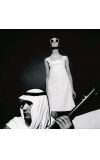
17 Dec 2012 03:35:57
Three talents led the movement – David Bailey, Brian Duffy and Terence Donovan. They were all working class and brought the reality and nuances of contemporary life to their photography, knocking down the ivory tower – all couture ball gowns, aristocratic-looking models and ladylike manners – that had dominated fashion to date.
While David Bailey is still alive and highly active in his profession today (and has published many books), Terence Donovan died in 1996, leaving a huge archive of work to his widow, Diana, who has compiled this hefty monograph with art director David Hillman.
Just when you thought there could not possibly be space for another fashion book rooted in the 1960s, this one proves rather compelling. It makes you question and appreciate the craft of good fashion photography and indeed good fashion. On a simplistic note, Donovan was a "good" fashion photographer because he unfailingly managed to show off the fashion in a clear and crisp manner – his professionalism pleased Vogue editors for many years. "With Terry, one would spend one's day laughing until your sides ached. But he always had such great command of the situation, no fussing about, always so direct," writes Grace Coddington, then a fashion editor at British Vogue, in her foreword.
But Donovan is also a "great" because he managed to capture the nuance and gesture of the time, bringing the energy of the London street (many shoots were on location), the naturalistic stance and "real moment" into the frame. It was a different universe from the mannered expressions and stances of the gentleman society photographers, such as Cecil Beaton, of the previous era: "Terence's approach to photography was so different, often breaking the 'expected rules' of fashion photography with lots on unusual angles, dramatic lighting and often a grainy quality to the photographs. It really was a totally new take on photography for its time," as Sir Paul Smith put it.The heavy paper and high quality reproduction rewards the viewer. In a 1965 shoot for Elle, a gamine model in graphic patterned suit by Dior, leather gloves and fedora is caught in a dramatic arc of light against a mosaic wall. The model appears defiant, punching the air, glaring at the lens and delivering what is now known as "attitude", but back then would have appeared threatening, radical. For Tatler there is the 1962 portrait of Jean Shrimpton in a wedding dress, sitting on a chair and looking forlorn, broken. The image skewed the promise of happy-ever-after bliss at a time of social upheaval.
It was in his menswear shoots that Donovan was really able to express his dark-humoured, sardonic view of life. An elegant, suited-and-booted male model and scowling schoolboy appear outside a modernist church in Bow Common bearing the inscription "This is the Gate of Heaven". Donovan's locations – pedestrian subways, industrial backdrops, East End streets – are fascinating in their own right.
The book, frustratingly, reveals little about the man – anecdotes are garnered from industry professionals rather than personal friends. But what you do appreciate in Robin Muir's sensitive text is context – the changing role of fashion, the role of media and how photographers collaborated with editors and art directors. Spreads from Man About Town and the Sunday Times magazine – bold graphics, dramatic framing, photo-reportage style, witty captions – are enthralling. In one taken from Man About Town, a model in a peacoat and tie is shot against the dark industrial landscape of the Midlands. The headline? "Man about the Black Country". These shoots presage so much of what was to come with the revolution of the style press of the 1990s. The Face and i-D photographers took on the baton, moulding themselves as ciphers of contemporary culture, further blurring the boundaries of photo-reportage, portraiture and fashion.
Donovan, who was born in the East End to a lorry-driver father, and trained at Bethnal Green Camera Club before apprenticing at photographer John French's studio, was apparently a larger-than-life character. Big in physical form, with piercing blue eyes and tremendous drive. "Fame," he told one interviewer, "is suspect, dangerous material, all right for going through airports and things like that, but it's not something to pay too much attention to. Life is ephemeral and quick. I'll just play the show until the curtain comes down."

